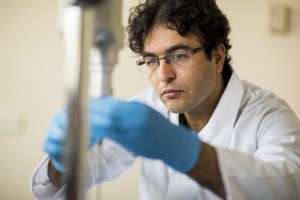Stopping mineral processing from turning to jelly

Cooking minerals in huge mixing tanks can turn them to jelly, and an Adelaide researcher has found out why. The work could save the industry millions of dollars a year in lost production and cleaning costs.
Sticky gel-like materials form during the liquid processing of mineral ores, when clays present in the deposits release elements such as silicon and aluminium into the liquid under particular conditions of temperature and acidity. That's what Dr Ataollah Nosrati, a research associate at the Ian Wark Research Institute (The Wark) of the University of South Australia has found.
To extract valuable metals, some of world's largest mineral deposits are mined and processed as concentrated slurries. This generally occurs in mixing tanks at high temperatures under aggressive acidic or alkaline conditions. Zinc silicate ores, for instance, are typically cooked at between 50 °C and 80 °C under very acidic conditions for a couple of hours.
But occasionally, the breakdown of the attached silicon compounds results in everything thickening into a gel. This kind of thing can also happen with other ores containing reactive clays or silicates.
"If we can prevent or mitigate this," Ataollah says, "it would lead to a higher recovery rate of valuable metals, lower operating costs, and a dramatic increase in throughput with a greatly reduced number of plant shutdowns. The decreased need for cleaning the mixing tanks would also increase safety."
"Ataollah identified and established plausible mechanisms responsible for gelation," said Prof Jonas Addai-Mensah, Associate Director (Minerals) at The Wark. "He also proposed possible mitigation strategies in actual mineral plants for this costly and intractable issue."
Due to their high solubility at elevated temperatures under acidic conditions, the clay-based minerals release significant amounts of gel-forming elements into the processing solution, Ataollah found. Reactions among these elements can have a significant impact on the particle interactions and flow behaviour in the solution, and that is what leads to gelling.
The research findings pave the way for enhancing our ability to process complex, low-grade ores of copper, gold, nickel and cobalt which contain silicates and aluminosilicate clays.
Ataollah Nosrati is one of 12 early-career scientists unveiling their research to the public for the first time thanks to Fresh Science, a national program sponsored by the Australian Government.
Provided by Science in Public




















